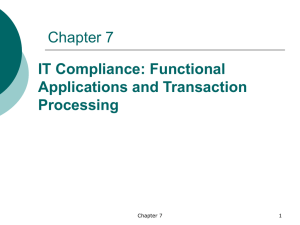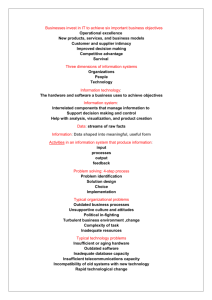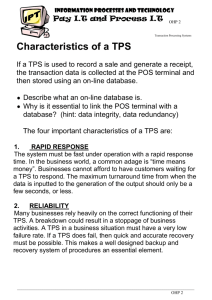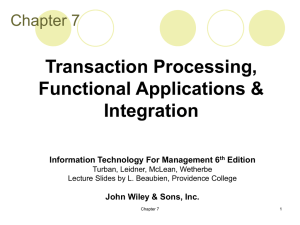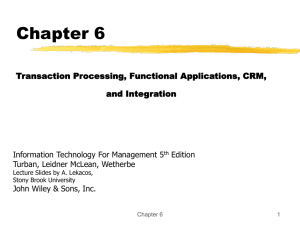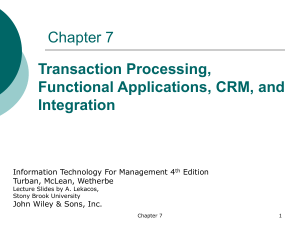Management Information Systems
advertisement
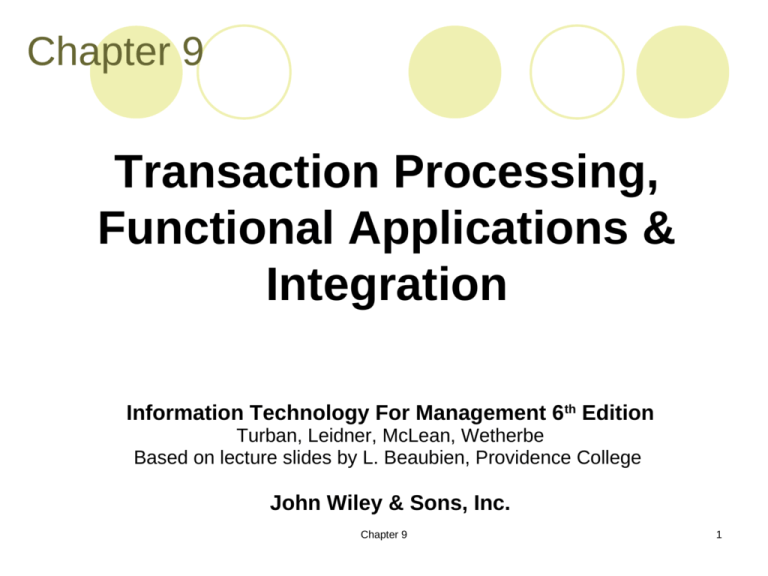
Chapter 9 Transaction Processing, Functional Applications & Integration Information Technology For Management 6th Edition Turban, Leidner, McLean, Wetherbe Based on lecture slides by L. Beaubien, Providence College John Wiley & Sons, Inc. Chapter 9 1 Functional Areas in a Business Chapter 9 2 Functional Information Systems Functional Information System supports one functional area within a company by increasing its internal effectiveness and efficiency. Flow of work and information between departments might suffer. Characteristics: ● Composed of smaller systems ● Integrated or independent ● Interfacing ● Supportive of different levels Chapter 9 3 Transaction Processing Information Systems Enable core operations of an organization Business transactions that support mission-critical activities TPS monitors, collects, stores, processes, and disseminates information for all core routine business transactions Typically involves high amount of data, and transactions rates, regular basis, high level of detail, high integrity and security concerns,... Batch processing (processing once per time interval) vs. online processing (as soon as transaction occurs) Chapter 9 4 TPS – Online Transaction Processing Systems With OLTP and Web technologies such as an extranet, suppliers can look at the firm’s inventory level or production schedule in real time. The suppliers themselves, in partnership with their customers, can then assume responsibility for inventory management and ordering. Interactive Internet TPS expands OLTP to provide enhanced real time transaction processing over the Internet or intranets. Multi-store chains can access a centralized computer system no longer requiring in-store processors. Chapter 9 5 TPS – Managing Production/Operations & Logistics Chapter 9 6 TPS – Managing Production/Operations & Logistics The production and operations management (POM) function in an organization is responsible for the processes that transform inputs into useful outputs. In comparison to the other functional areas, POM is very diversified as are the supporting TPS. It also differs considerably among organizations (hospital vs production). A few of the IT supported POM areas are: In-house logistics and materials management Planning production/operations Computer-integrated manufacturing (CIM) Chapter 9 7 TPS – In-House Logistics & Materials Management Logistics management deals with ordering, purchasing, inbound logistics (receiving), and outbound logistics (shipping) activities. These logistical activities cross several primary and secondary activities on the value chain. Inventory management determines how much inventory to keep. Overstocking can be expensive; so are understock conditions. Just-in-Time Systems is an approach that attempts to minimize waste of all kinds (space, labor, materials, energy, etc.) and to continuously improve processes and systems. The JIT concept is used in mass customization and build-to-order environments. Project Management. A project is usually a one-time effort composed of many interrelated activities, costing a substantial amount of money, and lasting for weeks or years. Software tools such as: program evaluation and review technique (PERT) and the critical path method (CPM) are used to manage milestones, resources, costs, etc. Chapter 9 8 TPS – Marketing and Sales - Customer Relations It is essential for companies to know who their customers are and to treat them properly. Innovative products and services, successful promotions, customization, and customer service are a necessity for most organization. Customer Profiles and Preference Analysis. Sophisticated information systems are being developed to collect data on existing and potential customers, their demographics (age, gender, income level), and preferences. Prospective Customer Lists and Marketing Databases. All firms need to know and track who their existing and potential customers are. These prospective-customer lists can be analyzed and sorted by classification for direct mailing, e-mailing, or telemarketing. Mass Customization. Today’s customers prefer customized products. Through mass customization, the practice of maintaining WIP inventory, manufacturers can offer different product configurations at reasonable prices. (DELL vs HP) Personalization. Special product offers are made, based on where the customer spent their time and on what they may have purchased (Cookies) Advertising and Promotions. Special promotions or coupons are presented to the customer via mails, email, wireless and pervasive computing applications. (based on shooping behaviour- ex:Flat TV, tracking eye movement in developig tv commercials) Chapter 9 9 TPS – Marketing and Sales - Distribution Channels & In-Store Innovations Organizations can distribute their products and services through a variety of delivery channels. A company may use its own outlets, mfg. Representatives, or distributors (to name a few). Improving Shopping and Checkout at Retail Stores Hand-held wireless devices that scan the bar code UPC Smart card or credit card Information kiosk enable customers to view catalogs in stores Self-checkout machines Check-writers attached to cash registers Computerization of various activities in retail stores Video-based systems count and track shoppers in a physical store Chapter 9 10 TPS – Marketing and Sales - Marketing Management Many marketing management decision applications are supported by computerized information systems. Pricing of Products or Services. Sales volumes are largely determined by the prices of products or services as is profit (yield management in airline industry. Salesperson Productivity. Salespeople differ from each other in selling skill. Sales-force automation increases salesperson productivity by providing them with mobile devices, access to information, etc. Profitability Analysis profit contribution of certain products and services can be derived from cost-accounting systems Sales Analysis And Trends. Marketing. TPS collect sales figures that can be searched for trends and relationships. New Products, Services, and Market Planning. New products and services can be an expensive risk. “Will it sell?” Requires careful analysis, planning, forecasting, and market research. (positionin, surveys, P&G) Web-Based Systems support marketing and sales through data capture Chapter 9 11 TPS – Accounting and Finance Systems Accounting and finance functional areas manage the inflow and outflow of organizational assets. This involves all functions of an organization including payroll, billing, cash management, etc. Financial Planning and Budgeting Financial and Economic Forecasting Planning for Incoming Funds Budgeting Capital Budgeting Managing Financial Transactions Financial and Economic Forecasting Planning for Incoming Funds Budgeting Capital Budgeting Chapter 9 12 TPS – Accounting and Finance Systems Investment Management Financial Analysis (NPV calculation to assess different investment options) Access to Financial and Economic Reports (Lexis Nexis) Control and Auditing Budgetary Control and Auditing Financial Ratio Analysis Profitability Analysis and Cost Control Product Pricing Risk assesment (Morgan Stanley) Chapter 9 13 TPS – Human Resources Systems Web­based systems have increased the popularity of human resources information systems which provide applications mainly related to acquiring, hiring, rewarding, developing, training, protecting and retaining human resources. Recruitment is finding employees, testing them, and deciding which ones to hire. The Web has enhanced the recruitment process. HRM Portals (Directemployer.com) Employee Selection Human Resources Maintenance and Development Performance Evaluation Training and Human Resources Development Chapter 9 14 Integration Business processes typically span several functional areas Need for integration of functional information systems Possibilities include integration using Web services or Middleware, or use of ERP systems (Enterprise Resource Planning), which support business processes throughout the organization Chapter 9 15 Integration Discussion • What problems might be associated with nonintegrated functional information systems throughout the organization? Chapter 9 16 Case Study Prepare the cast study “Dollar General Uses Integrated Software”, textbook p.363/364, for next class session. Chapter 9 17

